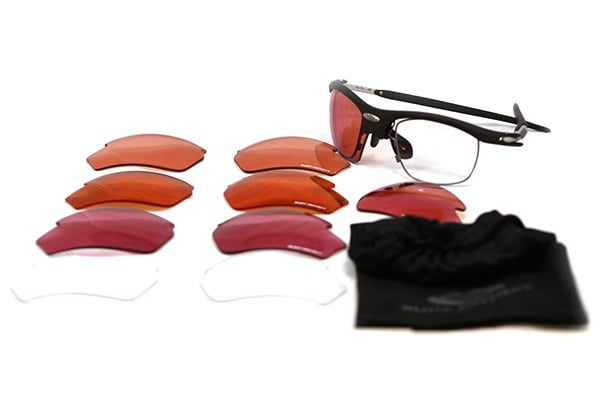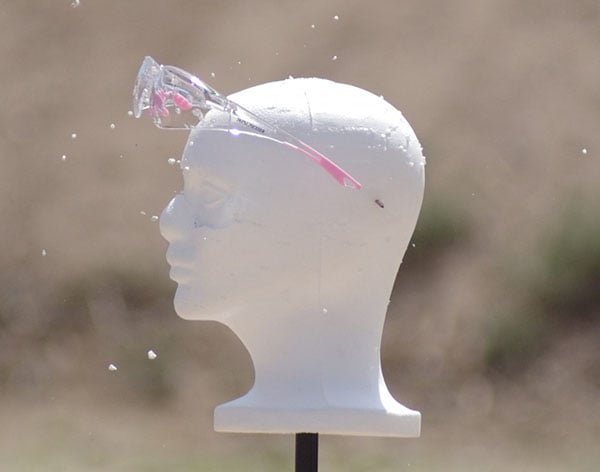Last Updated on
By Luke Brandenburg
Anyone who handles firearms knows that safety is extremely important, but have you thought about protecting your eyes? Quality shooting glasses can provide great protection from dangerous accidents and help you better handle any conditions you may face in the field.
Although any shooter with common sense knows the importance of safety when handling firearms, some overlook the value of eye protection. Just take a look at the experienced shooters around you, professional competition shooters, law enforcement, and even the military. You will see that almost all of them use eye protection.
Why Wear Shooting Glasses?
The right eye protection can be the difference between a close call and an eye patch in your future. In the worst case scenario, a pierced primer could shoot debris back towards your eye. Other scenarios could also throw spent brass and shrapnel at you from different angles.
Small particles such as dirt and dust can also be cause major issues if they get into your eyes when shooting. A cloud of dust in the eye can leave you temporarily blinded resulting in a dangerous situation for you and the people around you. The right shooting glasses can keep your eyes protected from shrapnel and clear of dirt so that you can operate your firearm safely.
Although wearing your everyday sunglasses is better than wearing nothing at all, these glasses are not designed to protect you from the hazards of shooting. Choosing the right pair of protective glasses designed specifically for shooting scenarios is essential to your safety. When looking for the right eye protection, there are many different factors to consider.
Lens Material – Impact Protection
Lens material represents the most important factor when choosing shooting glasses and eye protection. Polycarbonate, the same material compound used to create bullet-resistant glass, is the best choice for shooters. This thermoplastic polymer is lightweight, relatively inexpensive and extremely strong. Polycarbonate can offer shatter and scratch resistance along with UV protection.
When it comes to impact resistance, there are three major ratings you could see:
ANSI
The American National Standards Institute, or ANSI, is the most common rating for safety glasses. ANSI Z87.3 and Z87.1 provide guidelines for the minimum requirements manufacturers must meet for impact resistant glasses. You should stay away from any shooting glasses that do not reach the ANSI Z87.1 requirements at a minimum.
OSHA
The Occupational Safety and Health Administration, or OSHA, also offers standards for eye protection that include both impact resistance and side protection. Shooting glasses or goggles that meet OSHA standards will provide more complete protection.
US Military
The highest standards for shooting glasses are set by the US Military. Ballistic glasses that meet these standards must pass the MIL-PRF-31013 Impact Test, and shooting goggles must pass the MIL-DTL-43511D test. During each of these tests, a .15 or .22 caliber bullet is fired directly into the lens to test strength and retention. If the shooting glasses or goggles you choose meet the US Military standards, you should have very little to worry about in almost any shooting scenario.
UV Protection
Although impact protection may be the most obvious factor when choosing shooting glasses, protection from Ultraviolet, or UV, radiation is also very important. When considering UV protection, you should understand the three different forms of UV rays: UVA, UVB and UVC. Since the earth’s atmosphere filters UVC, this form is not a major concern. UVA can cause sun-related drug reactions, but it is not responsible for sunburn or eye damage.
UVB is the primary cause of prolonged eye damage, sunburn and some types of skin cancer. This is the UV ray form that you should be worried about when selecting eye protection. Most ANSI-certified shooting glasses provide great UVB protection, even in clear-colored lenses. In fact, contrary to popular thinking, the color of your lenses does not necessarily make any difference when it comes to UVB protection.
You should look for glasses that block at least 99 percent of UV radiation. Most of these shooting glasses will have labels that say “Blocks 99 to 100 percent of UV rays,” or “Offers UV absorption up to 400 nm,” or “Meets ANSI UV requirements.”
Lens Color
There are a wide variety of different colors and tints for shooting lenses. You can find mirror-coatings, rainbow-coatings and all kinds of gradients. Many shooting glasses also offer interchangeable lenses so that you can switch colors depending on conditions. Whether you have interchangeable lenses or not, it is essential to have a clear set with you to give maximum light transmission when looking down a scope. Here are some of the more common color choices and their advantages:
Smoke/Gray/Gray-Green
These are the most common of all the lens colors. They do a good job at blocking glare without altering color perception. This makes them a solid all-around choice for many conditions. Since gray is a “true,” or neutral color, it still allows the shooter to see all colors as they would with clear lenses. While these tints won’t enhance your target, they definitely come in handy when shooting on a bright, sunny day.
Amber/Brown/Tan
These colors are also very common, and they are quite effective in cloudy conditions. They help to block the diffused light commonly experienced on a cloudy day. In turn, they enhance contrast and depth perception. These colors are a good choice for all-around shooting, but do slightly alter the shooter’s color perception.
Yellow/Orange
Yellow and orange lens colors are known for their ability to improve contrast and provide a sense of heightened visual ability. Some darker variations are referred to as “driving lenses” for these same reasons. Yellow and orange colors block haze and diffused light very effectively. They also highlight the orange color of a typical target. In dim light situations, the brighter the yellow on your lens, the better you will be able see. Obviously, the benefits of these lens colors also come with the downside of color perception alteration.
Purple/Vermillion
When it comes to pure target shooting, purple and vermillion lens colors are also common. They greatly enhance an orange target, especially if you have a dark background like tall trees, for example. They also help to reduce glare. These lens colors may not be the best choice for other shooting scenarios such as hunting and tactical applications, and they may take a while to get used to if you’re focused solely on target shooting.
Frames
Quality shooting glasses should come with frames made from a lightweight, comfortable material such as plastic, aluminum or even titanium. For added comfort, some shooting glasses offer adjustable or highly-flexible frames. Some frame variations also wrap around the ear to help keep the glasses in place.
Nose pads are also an important part of shooting glasses. Adjustable nose pads are best to keep the frame in the optimal position. The pads should be made from a soft, ultra-comfortable material like silicone.
At the end of the day, you want your shooting glass frames to be extremely comfortable and durable. Every experience shooter has sat-on, stepped-on a good pair of shooting glasses. If you use them enough, you will eventually do the same. A flexible, durable frame will come in handy when the time comes.
Although there are many other factors to consider when choosing shooting glasses, these issues will give you a great head start to finding the perfect one’s for you. Before you decide to purchase your next pair, stop by your local sporting goods store and try some different kinds on. You can still save some money by getting them online, but you will have a better idea of what feels right to you!














